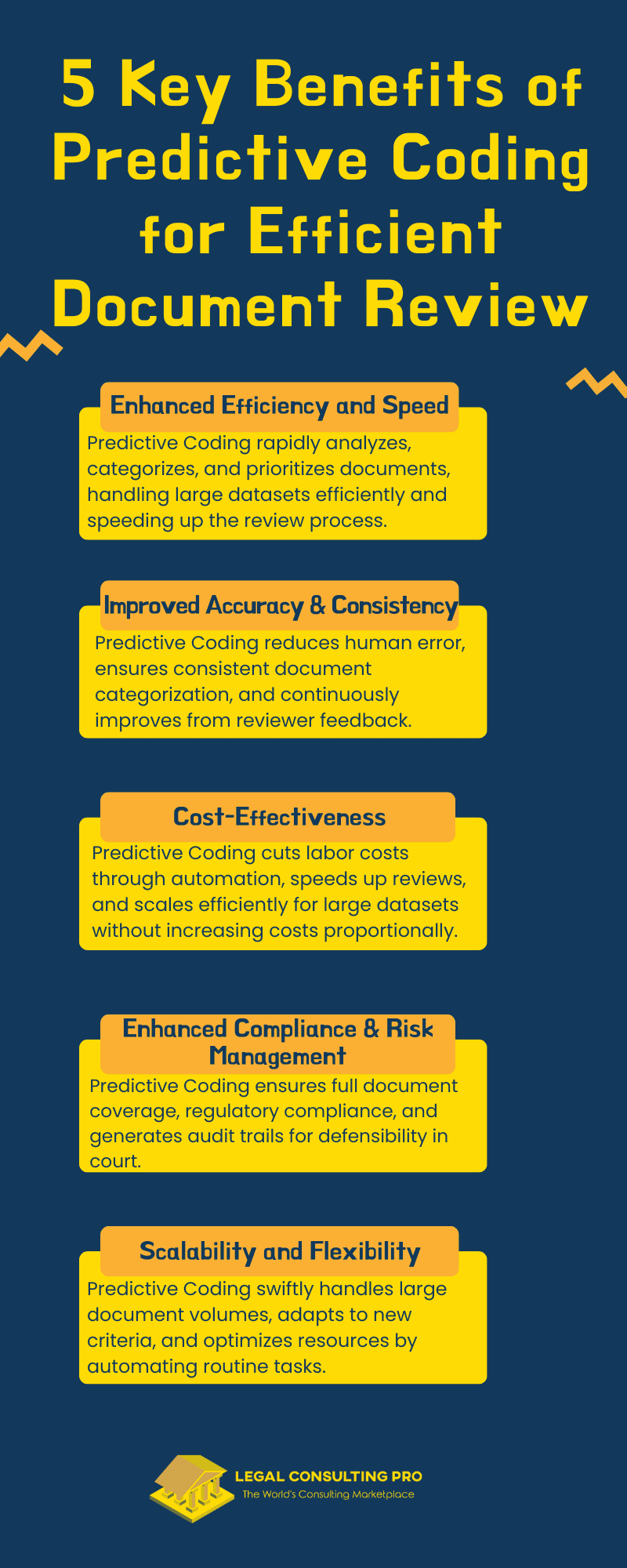The legal industry has seen transformative changes with the integration of technology, particularly in the area of Managed Document Review. One of the most significant advancements in this field is Predictive Coding. This technology leverages machine learning algorithms to streamline the document review process, making it faster, more efficient, and cost-effective. In this article, we will explore the five key benefits of Coding for efficient document review, highlighting how it is revolutionizing the practice of Managed Document Review.
Enhanced Efficiency and Speed
The Traditional Approach
Traditional document review methods are often labor-intensive and time-consuming. Lawyers and paralegals manually sift through vast volumes of documents, a process that can take weeks or even months, depending on the case size.
How Predictive Coding Enhances Efficiency
Coding significantly enhances the efficiency of the document review process. Here’s how:
- Automated Relevance Detection: Predictive Coding algorithms can quickly analyze and categorize documents based on their relevance to the case. This automation drastically reduces the time required for initial document sorting.
- Prioritization: By identifying the most relevant documents first, legal teams can focus their efforts where they matter most, accelerating the review process.
- Scalability: Coding can handle large datasets effortlessly, ensuring that even extensive document collections are reviewed promptly.
In the realm of Managed Document Review, this increased efficiency means legal teams can meet tight deadlines without compromising the thoroughness of their review.
Improved Accuracy and Consistency
Challenges in Manual Review
Manual document review is susceptible to human error and inconsistency. Different reviewers may interpret the same document differently, leading to varying levels of accuracy and potential oversights.
Predictive Coding’s Accuracy
Coding offers a solution to these challenges by:
- Reducing Human Error: Machine learning algorithms do not suffer from fatigue or cognitive biases, resulting in more accurate document categorization.
- Ensuring Consistency: Once trained, Predictive Coding systems apply the same criteria consistently across all documents, ensuring uniformity in the review process.
- Continuous Learning: These systems can continuously learn and improve from reviewer feedback, enhancing their accuracy over time.
For Managed Document Review services, this means providing clients with more reliable and consistent results, bolstering their confidence in the review process.
Cost-Effectiveness
High Costs of Traditional Review
The traditional document review process can be prohibitively expensive due to the high volume of billable hours required for manual review.
Cost Savings with Predictive Coding
Coding brings cost savings in several ways:
- Reduction in Labor Costs: By automating large portions of the review process, fewer human reviewers are needed, significantly lowering labor costs.
- Increased Efficiency: Faster review times translate to lower overall costs, as legal teams can complete reviews in a fraction of the time it would take manually.
- Scalability: Coding can handle large datasets without a proportional increase in costs, making it a cost-effective solution for large-scale document reviews.
For firms offering Managed Document Review services, these cost savings can be passed on to clients, making high-quality document review services more accessible and affordable.
Enhanced Compliance and Risk Management
Regulatory and Legal Risks
In the legal industry, ensuring compliance with regulatory requirements and managing risks associated with document review are critical.
How Predictive Coding Enhances Compliance
Coding enhances compliance and risk management by:
- Comprehensive Coverage: Coding algorithms can review every document in a dataset, ensuring that no potentially relevant documents are overlooked.
- Regulatory Adherence: The consistent application of review criteria helps ensure that reviews comply with relevant legal and regulatory standards.
- Audit Trails: Predictive Coding systems can generate detailed audit trails, documenting the review process and decisions made, which is crucial for regulatory compliance and defensibility in court.
For Managed Document Review providers, leveraging Coding means offering clients a higher level of assurance that their document review processes meet stringent compliance standards and reduce legal risks.
Scalability and Flexibility
Limitations of Manual Review
Manual document review is often limited by the availability of human reviewers and can struggle to scale up quickly to meet the demands of large or complex cases.
Scalability with Predictive Coding
Coding offers unparalleled scalability and flexibility:
- Handling Large Volumes: Coding systems can process and review vast quantities of documents swiftly, making them ideal for large-scale litigation or regulatory investigations.
- Adaptability: These systems can be quickly re-trained and adapted to new cases or changing review criteria, providing flexibility in response to evolving legal needs.
- Resource Optimization: By automating routine tasks, Coding allows human reviewers to focus on more complex and nuanced aspects of the review process, optimizing the use of available resources.
In the context of Managed Document Review, this scalability and flexibility mean that service providers can efficiently handle a wide range of cases, from small-scale reviews to massive document-heavy investigations, all while maintaining high standards of accuracy and compliance.

Implementing Predictive Coding in Managed Document Review
Best Practices for Implementation
To maximize the benefits of Coding in Managed Document Review, it’s essential to follow the best practices for implementation:
- Thorough Training: Ensure that the Coding system is thoroughly trained with a representative sample of documents. This initial training phase is crucial for the system to identify relevant and irrelevant documents accurately.
- Continuous Monitoring: Regularly monitor and validate the performance of the Coding system. This involves reviewing its decisions and providing feedback to improve its accuracy.
- Integration with Existing Processes: Integrate Coding seamlessly with existing document review workflows. This might involve using Predictive Coding to prioritize documents for manual review or to handle initial review phases.
- Stakeholder Engagement: Engage key stakeholders, including legal teams, IT professionals, and clients, in the implementation process to ensure buy-in and address any concerns about the technology.
- Transparency and Documentation: Maintain transparency in how the Coding system is used and document its processes and decisions. This documentation is critical for regulatory compliance and defensibility.
Overcoming Challenges
While Coding offers significant benefits, there are challenges to consider:
- Initial Setup Costs: Implementing Coding can involve significant initial costs for software, training, and system integration. However, these costs are often offset by long-term savings.
- Resistance to Change: Some legal professionals may be resistant to adopting new technology. Providing training and demonstrating the benefits of Coding can help overcome this resistance.
- Quality Control: Ensuring the quality and accuracy of Coding outputs requires ongoing monitoring and validation. This involves human oversight to address any errors or biases in the system.
Case Studies and Success Stories
Real-World Applications
Several real-world cases illustrate the transformative impact of Coding in Managed Document Review:
- Large-Scale Litigation: A global law firm used Coding to manage a document review project involving millions of documents. By leveraging Predictive Coding, the firm was able to reduce the review time from several months to just a few weeks, significantly cutting costs and improving accuracy.
- Regulatory Investigation: In a regulatory investigation involving a financial institution, Coding was used to quickly identify and review relevant documents. The technology enabled the institution to meet tight regulatory deadlines while ensuring compliance with all legal requirements.
- Internal Audit: A corporation conducts an internal audit using predictive coding to review many internal communications and documents. The technology helped identify potential compliance issues and provided insights for improving internal policies and procedures.
The Future of Predictive Coding and Managed Document Review
Evolving Technology
The future of Coding in Managed Document Review looks promising, with advancements in artificial intelligence and machine learning driving further improvements in accuracy, efficiency, and scalability. Here are some trends to watch:
- Advanced AI Algorithms: The development of more sophisticated AI algorithms will enhance the ability of Predictive Coding systems to understand and categorize complex documents.
- Integration with Other Technologies: Coding will increasingly integrate with other technologies, such as natural language processing (NLP) and sentiment analysis, to provide deeper insights and more nuanced document review capabilities.
- User-Friendly Interfaces: As technology evolves, Coding platforms will become more user-friendly, making it easier for legal professionals to leverage their capabilities without requiring extensive technical expertise.
Broader Adoption
As the benefits of Coding become more widely recognized, its adoption in Managed Document Review is expected to grow. Legal professionals and firms that embrace this technology will be better positioned to handle the demands of modern litigation, regulatory compliance, and internal investigations.
Conclusion
Predictive Coding is revolutionizing the field of Managed Document Review, offering unparalleled efficiency, accuracy, cost savings, compliance, and scalability. By automating large portions of the document review process, Coding enables legal professionals to focus on the most critical aspects of their cases, delivering better outcomes for clients and improving the overall quality of legal services.
As technology continues to advance, the integration of Coding into Managed Document Review will become increasingly sophisticated, driving further innovations and setting new standards for the legal industry. Legal professionals who embrace these advancements will be well-equipped to navigate the complexities of modern litigation and regulatory environments, ensuring that they remain competitive and effective in their practice.
Similar blogs:
Demystifying Predictive Coding: How AI Revolutionizes Managed Document Review
5 Key Factors to Consider When Outsourcing Managed Document Review for Legal Matters













































